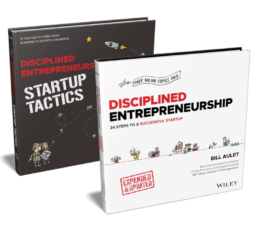Republished from Entrepreneur.com
Emerging entrepreneurs can learn valuable lessons from Bezos’s approach.
Jeff Bezos recently briefly overtook Bill Gates to become the richest man in America. It’s a reminder, much like Amazon’s most recent $13.7-billion acquisition of Whole Foods, of the remarkable power of the company that Bezos has created and the straightforward strategy he used to create his empire. Now, with each new click and each new transaction, Amazon grows its war chest of consumer and market data and the company’s growth appears — at least for the moment — unstoppable.
But it was not always so. Once upon a time, Amazon sold only books. Bezos’s initial focus on books constitutes the greatest execution of a beachhead marketing strategy ever. By creating a narrow and winnable focus for his first product, Bezos was able to build the fundamentals of his company and create a launching pad for Amazon to grow into different markets over time.
Today, when I want to buy audiobooks, gardening tools or a Spike Lee Brooklyn bicycle cap, I shop through Amazon and know it will all be delivered, courtesy of Amazon Prime, to my front door in Boston in two days. I have come to depend on Amazon’s recommendations and customer feedback to guide my purchases. I now have an Amazon TV system and have installed Alexa systems at both home and at work. My publisher directs me to the Amazon author section to see how many copies of my book have been sold each week, and in what regions. And when I relax at the end of the day, I read the Washington Post on my iPad, which is free with Amazon Prime. And it all started with books.
Emerging entrepreneurs can learn valuable lessons from Bezos’s approach. In this case, the book industry provided an ideal beachhead market because it was:
Really simple
In July 1994, the book market was such a simple business that Bezos was able to launch Amazon out of his garage with minimal investment. Books do not spoil, there are no development costs for the product, and products are easy to identify with great certainty as each book has a unique International Standard Book Number. While Amazon’s book business was not growing dramatically, there was consistent demand for the product.
Takeaway: The goal of a beachhead market is to start to generate some revenues, cash flow and potentially even some profits, with the least number of variables possible.
Easy to enter with a high chance of winning
In the 1990s, the sleepy book industry had not utilized technology like other industries. It was simply not a sexy market, and ambitious business people were looking elsewhere for high-growth opportunities. A determined effort by Amazon in the realm of books was much more likely to succeed rather than in the more popular and populated industries such as electronics, food or even pet supplies.
Takeaway: The ideal market has low entry costs. But once in, entrepreneurs can erect barriers, making it harder for others to enter.
Visible but not too visible
The big retailers did not feel Amazon was a threat because, after all, it was only selling books. However, once Amazon built a good reputation with its domination of the book market, it gained the ability to begin attacking additional markets with credibility and on their terms.
Takeaway: You initially want to win in a market that gives your company credibility, but doesn’t go for the heart of the big players’ business, which threatens them and impels them, to react forcefully — which could be the death knell for a fledgling startup.
A safe haven in which to build critical skills to win follow-on markets
In the early 1990s, Bezos determined that the internet was the future and he felt it was going to fundamentally change retail forever. He wanted to be there for this. The beachhead of books gave him a chance to build up a web-based marketplace, interact with customers and then fulfill the orders with an efficient backend operation. These skills were clearly transferrable. If he could perfect them in this simple market, he’d have a competitive advantage when he moved into adjacent and more attractive markets.
Takeaway: A relatively safe haven allows entrepreneurs to develop some fundamental core capability that can be leveraged into adjacent markets where the entrepreneur can reap greater rewards.
Are this business strategy and execution plan unique to Amazon? Not at all. For Apple, it was desktop publishing, which led to it becoming the computer of choice for creatives in their personal and professional lives. For Honda, its expertise around motorcycles led to innovations in engine design for power products such as lawnmowers, a beachhead that it leveraged over time to create luxury cars and now robots.
After brainstorming all the possibilities in a given market, you may find you have limited resources. As a military operation, you are much more likely to succeed if you focus those resources to win one beachhead market and then pick your head up and look for the next adjacent market to win. There’s an old Romanian proverb, The person who chases two rabbits, catches neither.
Bezos learned this lesson well and started with one slow, relatively ignored rabbit. Now he seems to be catching as many rabbits as he wants. The Normandy Invasion of the retail market, and our lives, has happened and it will not be easily stopped.
The author
Bill Aulet
A longtime successful entrepreneur, Bill is the Managing Director of the Martin Trust Center for MIT Entrepreneurship and Professor of the Practice at the MIT Sloan School of Management. He is changing the way entrepreneurship is understood, taught, and practiced around the world.

The Disciplined Entrepreneurship Toolbox
Stay ahead by using the 24 steps together with your team, mentors, and investors.
The books
This methodology with 24 steps and 15 tactics was created at MIT to help you translate your technology or idea into innovative new products. The books were designed for first-time and repeat entrepreneurs so that they can build great ventures.

How relevant was this article to you?
Click on a star to rate it!
Average rating 4.8 / 5. Vote count: 4
No votes so far! Be the first to rate this post.
We are sorry that this article was not useful for you!
Let us improve this post!
Tell us how we can improve this post?

By the way, the more I see of Bezos, the more I am impressed. People seem to have an infatuation with Elon Musk, and while I love all ethical entrepreneurs, Musk does not belong in the same league with Bezos. It will be interesting to see if Tesla can make it to 2025, let alone 2021. Amazon is a force that will likely have to be reigned in by the government because it will become so powerful.